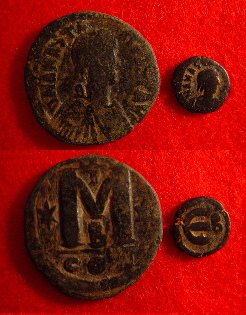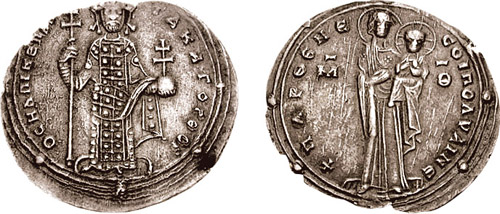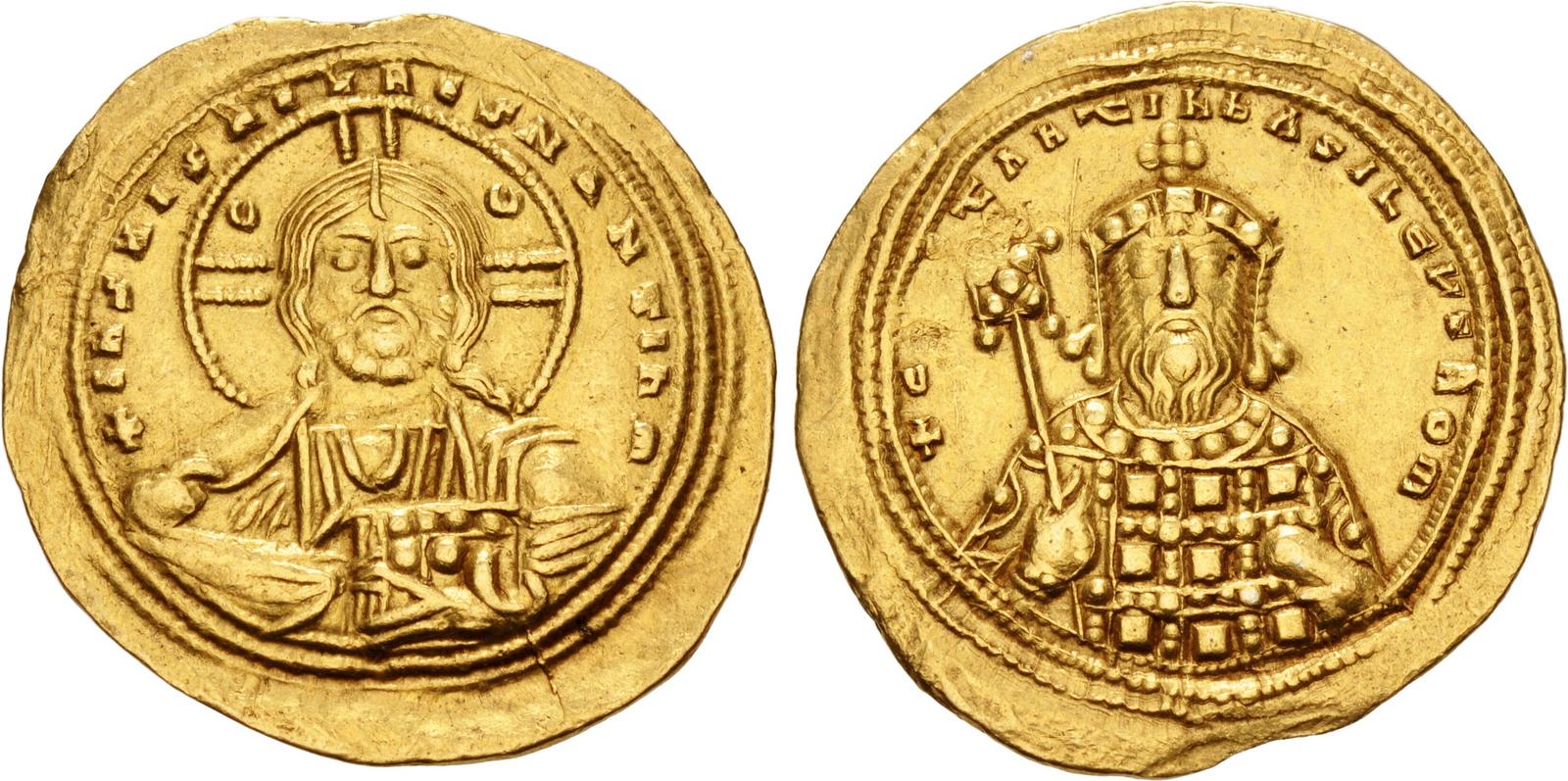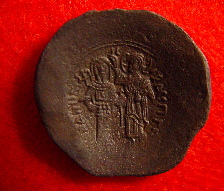Byzantine Coinage on:
[Wikipedia]
[Google]
[Amazon]
Byzantine currency, money used in the
 The type of Justinian II was revived after the end of
The type of Justinian II was revived after the end of
 New bronze coins, multiples of the ''nummus'' were introduced, such as the 40 ''nummi'' (also known as the '' follis''), 20 ''nummi'' (also known as the ''semifollis''), 10 ''nummi'' (also known as the ''decanummium'', and 5 ''nummi'' coins (also known as the ''pentanummium''); other denominations were occasionally produced. The obverse (front) of these coins featured a highly stylized portrait of the emperor while the reverse (back) featured the value of the denomination represented according to the Greek numbering system (M=40, Λ=30, K=20, I=10, E=5). Silver coins were rarely produced.
New bronze coins, multiples of the ''nummus'' were introduced, such as the 40 ''nummi'' (also known as the '' follis''), 20 ''nummi'' (also known as the ''semifollis''), 10 ''nummi'' (also known as the ''decanummium'', and 5 ''nummi'' coins (also known as the ''pentanummium''); other denominations were occasionally produced. The obverse (front) of these coins featured a highly stylized portrait of the emperor while the reverse (back) featured the value of the denomination represented according to the Greek numbering system (M=40, Λ=30, K=20, I=10, E=5). Silver coins were rarely produced.
 The only regularly issued silver coin was the
The only regularly issued silver coin was the  The Byzantine monetary system changed during the 7th century when the 40 ''nummi'' (also known as the '' follis''), now significantly smaller, became the only bronze coin to be regularly issued. Although
The Byzantine monetary system changed during the 7th century when the 40 ''nummi'' (also known as the '' follis''), now significantly smaller, became the only bronze coin to be regularly issued. Although
 Former money changer
Former money changer
 During Andronicus II's reign he instituted new denominations based on the hyperpyron. They were the silver miliaresion or basilika at 12 to the hyperpyron and the billon politika at 96 per hyperpyron,
along with the copper assaria, tournesia and follara.
The ''basilikon'' was a copy of the Venetian ducat and circulated from 1304 for fifty years.
The ''hyperpyron'' remained in regular issue and circulation until the 1350s, remaining in use thereafter only as a money of account. After 1400, Byzantine coinage became insignificant, as Italian money became the predominant circulating coinage.
These ''scyphate'' (cup-shaped) coins known as ''trachy'' were issued in both
During Andronicus II's reign he instituted new denominations based on the hyperpyron. They were the silver miliaresion or basilika at 12 to the hyperpyron and the billon politika at 96 per hyperpyron,
along with the copper assaria, tournesia and follara.
The ''basilikon'' was a copy of the Venetian ducat and circulated from 1304 for fifty years.
The ''hyperpyron'' remained in regular issue and circulation until the 1350s, remaining in use thereafter only as a money of account. After 1400, Byzantine coinage became insignificant, as Italian money became the predominant circulating coinage.
These ''scyphate'' (cup-shaped) coins known as ''trachy'' were issued in both
 During this last phase of Byzantine coinage gold issues were discontinued and a regular silver issue was commenced. The denomination was the Stavraton issued in 1, , and stavraton. Also issued were the copper follaro and tornesse.
During this last phase of Byzantine coinage gold issues were discontinued and a regular silver issue was commenced. The denomination was the Stavraton issued in 1, , and stavraton. Also issued were the copper follaro and tornesse.
Byzantine coinage by rulers
Digital Library Numis (DLN)
Online books and articles on Byzantine coins
Talking about Ancient and Byzantine Coins: Interview with Yannis Stoyas
An informative October 2015 interview on the Byzantine coinage with a leading Greek numismatist {{DEFAULTSORT:Byzantine Coinage Economy of the Byzantine Empire Coins of ancient Rome Numismatics
Eastern Roman Empire
The Byzantine Empire, also known as the Eastern Roman Empire, was the continuation of the Roman Empire centred on Constantinople during late antiquity and the Middle Ages. Having survived the events that caused the fall of the Western Roman E ...
after the fall of the West, consisted of mainly two types of coin
A coin is a small object, usually round and flat, used primarily as a medium of exchange or legal tender. They are standardized in weight, and produced in large quantities at a mint in order to facilitate trade. They are most often issued by ...
s: gold
Gold is a chemical element; it has chemical symbol Au (from Latin ) and atomic number 79. In its pure form, it is a brightness, bright, slightly orange-yellow, dense, soft, malleable, and ductile metal. Chemically, gold is a transition metal ...
solidi and hyperpyra and a variety of clearly valued bronze
Bronze is an alloy consisting primarily of copper, commonly with about 12–12.5% tin and often with the addition of other metals (including aluminium, manganese, nickel, or zinc) and sometimes non-metals (such as phosphorus) or metalloid ...
coins. By the 15th century, the currency was issued only in debased silver stavrata and minor copper coins with no gold issue. The Byzantine Empire
The Byzantine Empire, also known as the Eastern Roman Empire, was the continuation of the Roman Empire centred on Constantinople during late antiquity and the Middle Ages. Having survived History of the Roman Empire, the events that caused the ...
established and operated several mints
A mint or breath mint is a food item often consumed as an after-meal refreshment or before business and social engagements to improve breath odor. Mints are commonly believed to soothe the stomach, given their association with natural byproducts ...
throughout its history. Aside from the main metropolitan mint in the capital, Constantinople
Constantinople (#Names of Constantinople, see other names) was a historical city located on the Bosporus that served as the capital of the Roman Empire, Roman, Byzantine Empire, Byzantine, Latin Empire, Latin, and Ottoman Empire, Ottoman empire ...
, a varying number of provincial mints were also established in other urban centres, especially during the 6th century.
Most provincial mints except for Syracuse were closed or lost to Arab Muslim invasions in the Mediterranean Region by the mid-7th century onwards. After the loss of Syracuse in 878, Constantinople became the sole mint for gold
Gold is a chemical element; it has chemical symbol Au (from Latin ) and atomic number 79. In its pure form, it is a brightness, bright, slightly orange-yellow, dense, soft, malleable, and ductile metal. Chemically, gold is a transition metal ...
and silver
Silver is a chemical element; it has Symbol (chemistry), symbol Ag () and atomic number 47. A soft, whitish-gray, lustrous transition metal, it exhibits the highest electrical conductivity, thermal conductivity, and reflectivity of any metal. ...
coinage until the late 11th century, when major provincial mints began to re-appear. Many mints, both imperial and, as the Byzantine Empire fragmented, belonging to autonomous local rulers, were operated in the 12th to 14th centuries. Constantinople and Trebizond, capital of the independent Empire of Trebizond
The Empire of Trebizond or the Trapezuntine Empire was one of the three successor rump states of the Byzantine Empire that existed during the 13th through to the 15th century. The empire consisted of the Pontus, or far northeastern corner of A ...
(1204–1461), survived until the invasion of Anatolia by the Ottoman Turks
The Ottoman Turks () were a Turkic peoples, Turkic ethnic group in Anatolia. Originally from Central Asia, they migrated to Anatolia in the 13th century and founded the Ottoman Empire, in which they remained socio-politically dominant for the e ...
in the mid-15th century.
Iconography
Early Byzantine coins continue the late Greco-Roman conventions: on theobverse
The obverse and reverse are the two flat faces of coins and some other two-sided objects, including paper money, flags, seals, medals, drawings, old master prints and other works of art, and printed fabrics. In this usage, ''obverse'' ...
the head of the Roman Emperor, now full face rather than in profile; on the reverse, usually a Christian symbol such as the cross or an angel
An angel is a spiritual (without a physical body), heavenly, or supernatural being, usually humanoid with bird-like wings, often depicted as a messenger or intermediary between God (the transcendent) and humanity (the profane) in variou ...
(the two tending to merge into one another). The gold coins of Justinian II
Justinian II (; ; 668/69 – 4 November 711), nicknamed "the Slit-Nosed" (), was the last Byzantine emperor of the Heraclian dynasty, reigning from 685 to 695 and again from 705 to 711. Like his namesake, Justinian I, Justinian II was an ambitio ...
departed from these stable conventions by putting a bust of Christ on the obverse, and a half or full-length portrait of the Emperor on the reverse. These innovations incidentally had the effect of leading the Umayyad caliph ʿAbd al-Malik, who had previously copied Byzantine styles but replacing Christian symbols with Islamic equivalents, finally to develop a distinctive Islamic style, with only lettering on both sides. This was then used on nearly all Islamic coinage until the modern period.
 The type of Justinian II was revived after the end of
The type of Justinian II was revived after the end of iconoclasm
Iconoclasm ()From . ''Iconoclasm'' may also be considered as a back-formation from ''iconoclast'' (Greek: εἰκοκλάστης). The corresponding Greek word for iconoclasm is εἰκονοκλασία, ''eikonoklasia''. is the social belie ...
, and with variations remained the norm until the end of the Empire. In the 10th century, so-called "anonymous folles" were struck instead of the earlier coins depicting the emperor. The anonymous folles featured the bust of Christ on the obverse and the inscription "XRISTUS/bASILEU/bASILE", which translates to "Christ, Emperor of Emperors".
Byzantine coins followed, and took to the furthest extreme, the tendency of precious metal coinage to get thinner and wider as time goes on. Late Byzantine gold coins became thin wafers that could be bent by hand. The Byzantine coinage had a prestige that lasted until near the end of the Empire. European rulers, once they again started issuing their own coins, tended to follow a simplified version of Byzantine patterns, with full face ruler portraits on the obverse.
Denominations
The start of what is viewed as Byzantine currency by numismatics began with themonetary reform
Monetary reform is any movement or theory that proposes a system of supplying money and financing the economy that is different from the current system.
Monetary reformers may advocate any of the following, among other proposals:
* A return to ...
of Anastasius in 498, who reformed the late Roman Empire coinage system which consisted of the gold ''solidus'' and the bronze ''nummi''. The '' nummus'' was an extremely small bronze coin, at about 8–10 mm, weight of 0.56 g making it at 576 to the Roman pound
The units of measurement of ancient Rome were generally consistent and well documented.
Length
The basic unit of Roman linear measurement was the ''pes'' (plural: ''pedes'') or Roman foot. Investigation of its relation to the English foot goes ...
which was inconvenient because a large number of them were required even for small transactions.
 New bronze coins, multiples of the ''nummus'' were introduced, such as the 40 ''nummi'' (also known as the '' follis''), 20 ''nummi'' (also known as the ''semifollis''), 10 ''nummi'' (also known as the ''decanummium'', and 5 ''nummi'' coins (also known as the ''pentanummium''); other denominations were occasionally produced. The obverse (front) of these coins featured a highly stylized portrait of the emperor while the reverse (back) featured the value of the denomination represented according to the Greek numbering system (M=40, Λ=30, K=20, I=10, E=5). Silver coins were rarely produced.
New bronze coins, multiples of the ''nummus'' were introduced, such as the 40 ''nummi'' (also known as the '' follis''), 20 ''nummi'' (also known as the ''semifollis''), 10 ''nummi'' (also known as the ''decanummium'', and 5 ''nummi'' coins (also known as the ''pentanummium''); other denominations were occasionally produced. The obverse (front) of these coins featured a highly stylized portrait of the emperor while the reverse (back) featured the value of the denomination represented according to the Greek numbering system (M=40, Λ=30, K=20, I=10, E=5). Silver coins were rarely produced.
 The only regularly issued silver coin was the
The only regularly issued silver coin was the Hexagram
, can be seen as a compound polygon, compound composed of an upwards (blue here) and downwards (pink) facing equilateral triangle, with their intersection as a regular hexagon (in green).
A hexagram (Greek language, Greek) or sexagram (Latin l ...
first issued by Heraclius
Heraclius (; 11 February 641) was Byzantine emperor from 610 to 641. His rise to power began in 608, when he and his father, Heraclius the Elder, the Exarch of Africa, led a revolt against the unpopular emperor Phocas.
Heraclius's reign was ...
in 615 which lasted until the end of the 7th century, minted in varying fineness with a weight generally between 7.5 and 8.5 grams. It was succeeded by the initially ceremonial ''miliaresion
The ''miliaresion'' (, from ), is a name used for two types of Byzantine silver coins. In its most usual sense, it refers to the themed flat silver coin struck between the 8th and 11th Century.
History
Originally, the name was given to a series ...
'' established by Leo III the Isaurian
Leo III the Isaurian (; 685 – 18 June 741), also known as the Syrian, was the first List of Byzantine emperors, Byzantine emperor of the Isaurian dynasty from 717 until his death in 741. He put an end to the Twenty Years' Anarchy, a period o ...
in ca. 720, which became standard issue from ca. 830 on and until the late 11th century, when it was discontinued after being severely debased. Small transactions were conducted with bronze coinage throughout this period.
The gold '' solidus'' or ''nomisma
''Nomisma'' () was the ancient Greek word for "money" and is derived from nomos () meaning "'anything assigned,' 'a usage,' 'custom,' 'law,' 'ordinance,' or 'that which is a habitual practice.'"The King James Version New Testament Greek Lexicon; ...
'' remained a standard of international commerce until the 11th century, when it began to be debased under successive emperors beginning in the 1030s under the emperor Romanos Argyros
Romanos III Argyros (; Latinized Romanus III Argyrus; 968 – 11 April 1034), or Argyropoulos, was Byzantine Emperor from 1028 until his death in 1034. He was a Byzantine noble and senior official in Constantinople when the dying Constantine ...
(1028–1034). Until that time, the fineness of the gold remained consistent at about 0.955–0.980.
 The Byzantine monetary system changed during the 7th century when the 40 ''nummi'' (also known as the '' follis''), now significantly smaller, became the only bronze coin to be regularly issued. Although
The Byzantine monetary system changed during the 7th century when the 40 ''nummi'' (also known as the '' follis''), now significantly smaller, became the only bronze coin to be regularly issued. Although Justinian II
Justinian II (; ; 668/69 – 4 November 711), nicknamed "the Slit-Nosed" (), was the last Byzantine emperor of the Heraclian dynasty, reigning from 685 to 695 and again from 705 to 711. Like his namesake, Justinian I, Justinian II was an ambitio ...
(685–695 and 705–711) attempted a restoration of the ''follis'' size of Justinian I
Justinian I (, ; 48214 November 565), also known as Justinian the Great, was Roman emperor from 527 to 565.
His reign was marked by the ambitious but only partly realized ''renovatio imperii'', or "restoration of the Empire". This ambition was ...
, the ''follis'' continued to slowly decrease in size.
In the early 9th century, a three-fourths-weight solidus was issued in parallel with a full-weight solidus, both preserving the standard of fineness, under a failed plan to force the market to accept the underweight coins at the value of the full weight coins. The 11⁄12 weight coin was called a ''tetarteron
The ''tetarteron'' (, "quarter oin) was a Byzantine Empire, Byzantine term applied to two different coins, one gold circulating from the 960s to 1092 in parallel to the ''histamenon'', and one copper used from 1092 to the second half of the 13t ...
'' (a Greek
Greek may refer to:
Anything of, from, or related to Greece, a country in Southern Europe:
*Greeks, an ethnic group
*Greek language, a branch of the Indo-European language family
**Proto-Greek language, the assumed last common ancestor of all kno ...
comparative adjective, literally "fourth-er"), and the full weight solidus was called the '' histamenon''. The ''tetarteron'' was unpopular and was only sporadically reissued during the 10th century. The full weight solidus was struck at 72 to the Roman pound, roughly 4.48 grams in weight. There were also solidi of weight reduced by one ''siliqua'' issued for trade with the Near East. These reduced solidi, with a star both on obverse and reverse, weighed about 4.25 g.
The Byzantine solidus was valued in Western Europe, where it became known as the ''bezant
In the Middle Ages, the term bezant (, from Latin ) was used in Western Europe to describe several gold coins of the east, all derived ultimately from the Roman . The word itself comes from the Greek Byzantion, the ancient name of Constantinop ...
'', a corruption of ''Byzantium''. The term ''bezant'' then became the name for the heraldic symbol of a roundel, tincture or – i.e. a gold disc.
Alexius I reforms
 Former money changer
Former money changer Michael IV the Paphlagonian
Michael IV the Paphlagonian (; c. 1010 – 10 December 1041) was Byzantine Emperor from 11 April 1034 to his death on 10 December 1041.
The son of a peasant, Michael worked as a money changer until he was found a job at court by his brother ...
(1034–41) assumed the throne of Byzantium in 1034 and began the slow process of debasing both the ''tetarteron nomisma'' and the ''histamenon nomisma''. The debasement was gradual at first, but then accelerated rapidly. about 21 carats (87.5% pure) during the reign of Constantine IX (1042–1055), 18 carats (75%) under Constantine X (1059–1067), 16 carats (66.7%) under Romanus IV (1068–1071), 14 carats (58%) under Michael VII (1071–1078), 8 carats (33%) under Nicephorus III (1078–1081) and 0 to 8 carats during the first eleven years of the reign of Alexius I (1081–1118). Under Alexius I Comnenus (1081–1118) the debased solidus (''tetarteron'' and ''histamenon'') was discontinued and a gold coinage of higher fineness (generally .900-.950) was established, commonly called the ''hyperpyron
The ''hyperpyron'' (, ''nómisma hypérpyron'' ) was a Byzantine coin in use during the late Middle Ages, replacing the '' solidus'' as the Byzantine Empire's standard gold coinage in the 11th century. It was introduced by emperor Alexios I Komneno ...
'' at 4.45 grs. The ''hyperpyron'' was slightly smaller than the solidus.
It was introduced along with the electrum '' aspron trachy'' worth a third of a ''hyperpyron'' and about 25% gold and 75% silver, the billon ''aspron trachy'' or '' stamenon'' valued at 48 to the hyperpyron and with 7% silver wash and the copper ''tetarteron
The ''tetarteron'' (, "quarter oin) was a Byzantine Empire, Byzantine term applied to two different coins, one gold circulating from the 960s to 1092 in parallel to the ''histamenon'', and one copper used from 1092 to the second half of the 13t ...
'' and '' noummion'' worth 18 and 36 to the billon ''aspron trachy''.
Andronicus II reforms
 During Andronicus II's reign he instituted new denominations based on the hyperpyron. They were the silver miliaresion or basilika at 12 to the hyperpyron and the billon politika at 96 per hyperpyron,
along with the copper assaria, tournesia and follara.
The ''basilikon'' was a copy of the Venetian ducat and circulated from 1304 for fifty years.
The ''hyperpyron'' remained in regular issue and circulation until the 1350s, remaining in use thereafter only as a money of account. After 1400, Byzantine coinage became insignificant, as Italian money became the predominant circulating coinage.
These ''scyphate'' (cup-shaped) coins known as ''trachy'' were issued in both
During Andronicus II's reign he instituted new denominations based on the hyperpyron. They were the silver miliaresion or basilika at 12 to the hyperpyron and the billon politika at 96 per hyperpyron,
along with the copper assaria, tournesia and follara.
The ''basilikon'' was a copy of the Venetian ducat and circulated from 1304 for fifty years.
The ''hyperpyron'' remained in regular issue and circulation until the 1350s, remaining in use thereafter only as a money of account. After 1400, Byzantine coinage became insignificant, as Italian money became the predominant circulating coinage.
These ''scyphate'' (cup-shaped) coins known as ''trachy'' were issued in both electrum
Electrum is a naturally occurring alloy of gold and silver, with trace amounts of copper and other metals. Its color ranges from pale to bright yellow, depending on the proportions of gold and silver. It has been produced artificially and is ...
(debased gold) and billon (debased silver). The exact reason for such coins is not known, although it is usually theorized that they were shaped for easier stacking.
1367 reform
 During this last phase of Byzantine coinage gold issues were discontinued and a regular silver issue was commenced. The denomination was the Stavraton issued in 1, , and stavraton. Also issued were the copper follaro and tornesse.
During this last phase of Byzantine coinage gold issues were discontinued and a regular silver issue was commenced. The denomination was the Stavraton issued in 1, , and stavraton. Also issued were the copper follaro and tornesse.
Buying power
It is possible to get some small snapshots in time, specific to region, culture and local inflation. The literary world is littered with references to prices from different time frames. A good portion of them may be inaccurate or tainted by translation. At Jerusalem in the sixth century a building worker received solidus per day, that is 21 folles. A casual labourer at Alexandria in the early seventh century earned solidus. A family's vegetable allowance for one day cost 5 folles. A pound of fish 6 folles, a loaf of bread was 3 folles worth at a time of shortage. The cheapest blanket was worth solidus, a second-hand cloak 1 solidus, and a donkey 3 or 4 solidi.Mango, Cyril. (1980) "Byzantium: the empire of New Rome". Weidenfeld and Nicolson. Page 40.Relative values
See also
* ''Bezant
In the Middle Ages, the term bezant (, from Latin ) was used in Western Europe to describe several gold coins of the east, all derived ultimately from the Roman . The word itself comes from the Greek Byzantion, the ancient name of Constantinop ...
''
* Economic history of Greece and the Greek world
* '' Grosso''
* Japanese ''mon''
* Medieval Bulgarian coinage
Medieval Bulgarian coinage were the coins minted by the Bulgarian Emperors during the Middle Ages at the time of the Second Bulgarian Empire.
There is no evidence that coins were minted during the First Bulgarian Empire, and minting ceased after ...
* Medieval Serbian coinage
* Roman currency
Roman currency for most of Roman history consisted of gold, silver, bronze, orichalcum#Numismatics, orichalcum and copper coinage. From its introduction during the Roman Republic, Republic, in the third century BC, through Roman Empire, Imperial ...
* Sasanian coinage
Notes
References
Sources
* * * *External links
Byzantine coinage by rulers
Digital Library Numis (DLN)
Online books and articles on Byzantine coins
Talking about Ancient and Byzantine Coins: Interview with Yannis Stoyas
An informative October 2015 interview on the Byzantine coinage with a leading Greek numismatist {{DEFAULTSORT:Byzantine Coinage Economy of the Byzantine Empire Coins of ancient Rome Numismatics